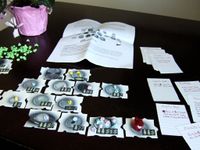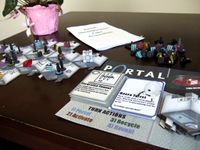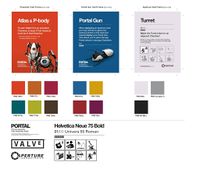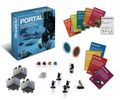Portal: The Uncooperative Cake Acquisition Game
| This article is non-canon. | ||
|---|---|---|
The subject matter of this article does not take place in the "real" Half-Life and Portal universe and is considered non-canon. |
This article is a stub. Maybe you can help by expanding it. |
|---|

| |
| Portal: The Uncooperative Cake Acquisition Game | |
|---|---|
| Developer(s) | |
| Release date(s) |
September 23, 2015 |
| Genre(s) | |
| Distribution | |
| Designer(s) | |
- "With a grinding of gears and some uneasy rumbling, Aperture Laboratories has resumed testing! Your team of Test Subjects have entered the Lab and are ready to perform all sorts of important, dignified, and dangerous testing procedures… all in the pursuit of Cake! It’s a fun and funny fast-paced fight to the finish. And by finish, we mean your team probably died."
- —Cryptozoic Entertainment[src]
Portal: The Uncooperative Cake Acquisition Game[1] is a competitive strategy tabletop game based on the Portal series, developed by Cryptozoic Entertainment in conjunction with Valve Corporation, released on September 23, 2015.[1]
Contents
Overview[edit]
|
The game is meant for two to four players who guide their own colored (purple, blue, yellow or red) Bendy Test Subjects around a tiled board in order to gather the biggest number of cake slices.
The box features a manual, a resource board, 18 double-sided Test Chamber Panels, 20 double-sided Aperture/character cards, 4 oversized Portal Gun cards, 32 Test Subject and 32 cake slice miniatures (8 for each player), one Turret miniature, one Weighted Companion Cube miniature, 2 portal tokens, one GLaDOS token, and a Steam activation code for Portal 2.[1]
Development[edit]
The concept of a Portal board game originates from Valve. In the summer of 2012, the developers behind Portal and Portal 2 decided to create a tabletop game in the form of a jigsaw puzzle based on the series. It was to revolve about the Multiverse and its many Earths, featuring dual-sided board pieces of the same shape. In a few days' time, the first prototype was created.[2]
As remarked by Jeep Barnett, the internal team wasn't big, with two to three persons actively working on it at a time, and about a dozen people involved in total. According to him, the core mechanic struck the team as unique and compelling from the very first prototype, and as it evolved, it survived their rigorous process of external playtesting and iteration. He explained that while Valve has worked on other board game ideas, this is the first that they're sure meets the quality bar that customers expect from the company.
The idea of the game ending when any player is eliminated, so that nobody sits out while the game continues, was maintained since the beginning of its development. Many other mechanics, including the core strategic gameplay that remains in the final game, also survived the process - for example, the functions of the Turret and the Companion Cube miniatures originate from those of the Octopus and the Fish ones. In the early versions, Test Subjects were grouped on Earth tiles and sacrificed to earn rewards as the board was reconfigured around them.[3]
Originally, the game featured randomization-based mechanics that turned out to be frustrating for players, who didn't want to plan around dice rolls or shuffled cards, rarely opting for random prizes. The developers decided to turn the card deck face up so that all players could see and compete for the next reward. Leaving Aperture Cards face up created the opportunity to place characters from Portal on the back; they present special twists on the rules so that each game has a unique flavor.[4]
Valve tweaked the game for months while developing strategies and counters, but one glaring flaw seemed impossible to solve; once a player had taken the lead they would almost always remain in the lead for the entire session. Valve tried adding cards that specifically targeted the leader, but they felt unfair and never seemed to show up at the right time. The team was stumped until a group of playtesters misread the rules and placed their points on the board along with Test Subjects. This accident turned into a great solution.[5] And so, players could carry points around the board, but when a tile was moved, all the points on that tile were permanently destroyed. This forced players in the lead to work harder to maintain the lead. Dramatic comebacks became much more common and advanced players were given an additional layer of strategy to manage.[6] Destroying points became such a fun moment that the team built an incinerator to play up the theatrics.[7]
The game’s rules were now solid enough that the next big flaw became clear; the theme was too far on the periphery of Portal lore. Even diehard fans of the franchise found it tenuous to base a game on a trailer for a PC exclusive expansion. Rethinking the art also gave Valve a chance to change the shape of the tiles where the laser-cut puzzle shapes had been difficult to snap together.[8] Players loved moving around the more familiar laboratory and playing with the tiny 3D-printed cake slices. However, the change in tile shape made it much more difficult to explain the rules for connecting them. The team tried splitting the game rules into Beginner and Advanced modes to simplify learning. This seemed promising, so they went more extreme and separated the rules into several 'upgrades' to be 'unlocked' via Scientific Achievements.[9] Reactions to this metagame were joy, revulsion, and everything between. Valve scrapped the idea and brought in the tabletop design experts at Cryptozoic. Jeep Barnett stated that Valve approached Cryptozoic in early 2013, hoping to enlist the tabletop publisher to lend its expertise and "add a final layer of polish." The company was impressed by what the team at Valve had put together, and was eager to work with them.[10] They spent a year polishing the game by refining the tile placement rules, rebalancing the cards, and making portals more integral. By playtesting the new changes, the team found that it was no longer necessary to separate the 'Advanced' instructions.[11]
According to Cory Jones, Cryptozoic's president and chief creative officer, the company found that it didn't have to make massive changes to Valve's prototype, since "they had a really solid, functioning game already." When asked what the publisher brought to the table that Valve may not have been able to provide, Jones said, "I think they could've done all of it internally, eventually." Instead, the work has consisted of "sharpening up" the design, and Cryptozoic has only needed to offer "minimal input," according to Jones.[10]
With the game fully designed, Valve artists focused creating a coherent style for the packaging and materials. They settled on an aesthetic where the game had been developed by Aperture itself and sat in a back room for decades. The color palette evokes a past era of family fun with a touch of Portal’s minimalism. The box test compositions below borrow photos from another game, but the final box uses their own photo shoot complete with vintage sweaters.
According to Jeep Barnett, the game "was designed to stand on its own, not as a promotional tool. While it may appeal more immediately to Portal fans, we tried to create something that was entertaining for everyone who tries it." He also remarked that "if this release goes well and gamers say they want more, we'll likely pursue more gameplay in the tabletop space."[10]
The tabletop game was given several names during its development. Two of them - Portal: Multiversal Exploitation Directive and Portal: Uncooperative Multiversal Exploitation can be seen in a development photo.[2] The game's official title slightly changed since February 2014, when it was announced as Portal: Uncooperative Cake Acquisition Game.[10][12] Originally set for release in late 2014,[10] it was delayed until the third quarter of 2015,[13] until finally being released in September.
Gallery[edit]
At least one image in this gallery is not captioned. You can help by describing the files below. |
Pre-release[edit]
Retail[edit]
Character cards[edit]
Aperture cards[edit]
Cake.
Components[edit]
Manual[edit]
External links[edit]
References[edit]
- ↑ 1.0 1.1 1.2 Portal: The Uncooperative Cake Acquisition Game on Cryptozoic Entertainment
- ↑ 2.0 2.1
 Portal Board Game - Behind The Scenes on Facebook
Portal Board Game - Behind The Scenes on Facebook
- ↑
 Portal Board Game - Behind The Scenes on Facebook
Portal Board Game - Behind The Scenes on Facebook
- ↑
 Portal Board Game - Behind The Scenes on Facebook
Portal Board Game - Behind The Scenes on Facebook
- ↑
 Portal Board Game - Behind The Scenes on Facebook
Portal Board Game - Behind The Scenes on Facebook
- ↑
 Portal Board Game - Behind The Scenes on Facebook
Portal Board Game - Behind The Scenes on Facebook
- ↑
 Portal Board Game - Behind The Scenes on Facebook
Portal Board Game - Behind The Scenes on Facebook
- ↑
 Portal Board Game - Behind The Scenes on Facebook
Portal Board Game - Behind The Scenes on Facebook
- ↑
 Portal Board Game - Behind The Scenes on Facebook
Portal Board Game - Behind The Scenes on Facebook
- ↑ 10.0 10.1 10.2 10.3 10.4 How Valve and Cryptozoic came together for a Portal board game at Polygon
- ↑
 Portal Board Game - Behind The Scenes on Facebook
Portal Board Game - Behind The Scenes on Facebook
- ↑ Cryptozoic Entertainment official website
- ↑ Delayed Until Q3 2015 on BoardGameGeek Forums








































































